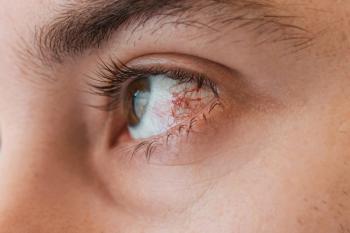
- Vol. 11 No. 5
- Volume 11
- Issue 5
Assessing visual crowding and its impact on glaucoma patients
I was never any good at those search-and-find books as a kid. Where’s Waldo eluded me for years. As an adult, my own children have much more of a knack for it than I ever did (or do to this day). Should I be worried about my relatively poor performance at such games, or is this just me being me?
A 2019 study published in Investigative Ophthalmology and Visual Science examines a functional aspect of glaucomatous damage that deserves more attention than it currently receives.1
ODs learn of the crowding phenomenon when studying amblyopia in school (see Figure 1, to the bottom right). Testing visual acuity on amblyopic patients using crowded optotypes has been studied for years.2
Trial subjects
However, visual crowding may also have implications for the functional assessment of
Visual crowding was determined by having each subject determine the orientation of the letter “T” presented 10 degrees away from a fixation target in each quadrant. The optotype was crowded, or “flanked,” by two letter “Hs,” and the subjects were asked to determine whether the T was upright or downright during 12 testing blocks consisting of 50 trials a piece for a total of 600 trials.
Prior to the crowding trials, the researchers tested to see if the subjects could initially see the letter T in each quadrant in order to determine if anyone would perform poorly simply because the optotype was in an area of glaucomatous visual field loss.
In addition to standard visual field testing, dilated eye examinations and baseline optical coherence tomography (OCT) studies were obtained on each study participant in order to quantify glaucomatous damage and isolate confounding diseases or conditions that could also cause visual impairment.
Only patients with open angles by gonioscopy were included, and ocular hypertensives without evidence of glaucoma (defined in this study as two or more consecutive abnormal visual field studies and glaucomatous-appearing optic discs) were excluded.
Related:
Study results
The results of this small-scale pilot study were intriguing and should be further investigated with more and larger studies. Not only did the subjects in the glaucoma wing of the study have more difficulty with visual crowding, but quantification of their test scores showed a significant correlation with their retinal nerve fiber layer (RNFL) thicknesses, as measured by OCT studies.
Specifically, for every 10 µm decrease in RNFL thickness, there was a 6.6-degree increase in the minimum distance the crowding flankers had to be from the target in order to negatively affect test performance.
The subjects with glaucoma were significantly affected by visual crowding, and the effect of crowding correlated with the severity of glaucomatous damage.
The study authors also point out that the crowding phenomenon occurs in the cortex of the brain and not within the ocular component of the visual system.3
This notion leads to the concept of glaucoma as a neurological disease instead of being purely isolated to one’s eyeballs.
Related:
Why are these findings of particular significance? The visual world is busy and filled with real-life manifestations of the crowding phenomenon (see Figure 2, to the right).
Solving everyday visual tasks can be difficult enough with a visual system that is completely intact. Functional damage from, say glaucoma, for example, is known to make matters worse.
But studies such as this help answer the “why” aspect of this notion.
Additionally, as stated earlier, the glaucoma wing’s relative difficulty with respect to visual crowding as compared to the control wing had significant correlation with decreased RNFL thickness.
Related: Rethinking what we know about glaucoma in 2019
Takeaways
I am eager to read the results of future, larger studies, keeping in mind that the assessment of visual crowding may be another valuation of visual function for glaucoma patients (besides standard automated perimetry and the like).
Having a relatively easy test such as this in the OD armory provides more of a real-life assessment of patients with vision impairment from glaucoma-which important for ODs in understanding how patients perceive the world around them.
The pictures ODs show to patients about how different types of visual impairment look are useful for educational purposes. However, they are only oversimplified tips of the iceberg of what patients actually perceive.
Personally, reading studies such as this one makes me aware that my understanding of functional impairment in glaucoma-which I hope is currently comprehensive-leaves much to be desired.
References:
1. Ogata NG, Boer ER, Daga FB, Jammal AA, Stringham JM, Medeiros FA. Visual crowding in glaucoma. Invest Ophthalmol Vis Sci. 2019 Feb 1;60(2):538-543.
2. Levi DM, Klein SA. Vernier acuity, crowding and amblyopia. Vision Res. 1985;25:979–991.
3. Pelli DG. Crowding: a cortical constraint on object recognition. Curr Opin Neurobiol. 2008 Aug;18(4):445–451
Articles in this issue
over 6 years ago
Travoprost eluting drug-delivery device shows promiseover 6 years ago
How private equity affects optometryover 6 years ago
Know what practice metrics to measureover 6 years ago
How to control myopia progression in your practiceover 6 years ago
How to determine an ideal LASIK candidateover 6 years ago
How to build your practice through social mediaover 6 years ago
Consider the whole patient when treating glaucomaover 6 years ago
Role of insulin therapy in diabetes and diabetic retinopathyover 6 years ago
I introduce myself to patients as Benover 6 years ago
Revamp your patient handoffNewsletter
Want more insights like this? Subscribe to Optometry Times and get clinical pearls and practice tips delivered straight to your inbox.



















































.png)


